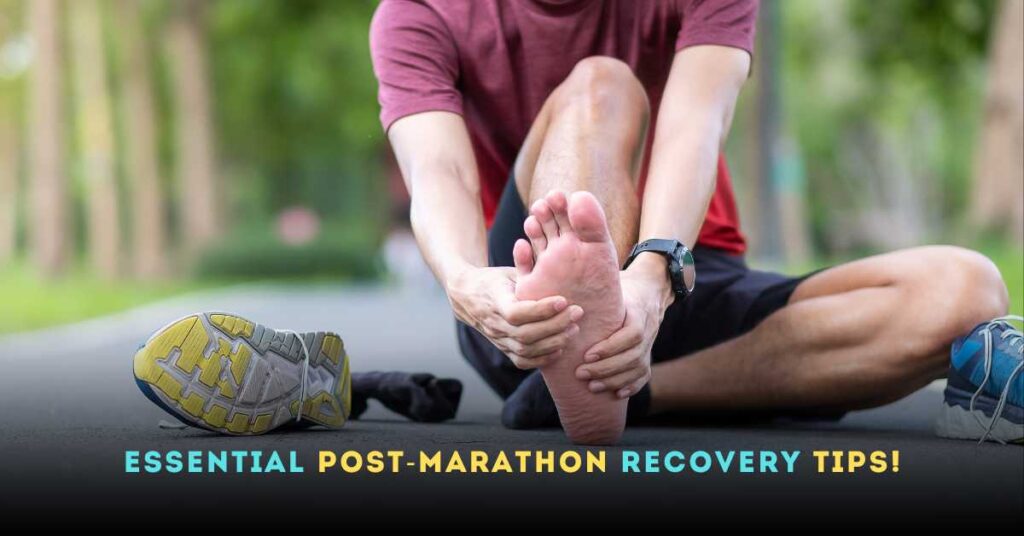Dear Runners!
We know that after running a marathon, you may be feeling tired and experiencing pain. Proper post-race recovery is crucial to help your body heal and to prevent injury. To assist you in this process, we have compiled a comprehensive guide with detailed tips to help alleviate your pain and speed up your recovery. Let’s dive in!
Essential Post-Marathon Recovery Tips:
1. Hydrate
Hydration is critical immediately after completing a marathon. During the race, you lose a significant amount of fluids through sweat, and replenishing these fluids is essential to avoid dehydration. Water is your best friend here, but sports drinks can also be beneficial as they help replenish electrolytes such as sodium, potassium, and magnesium, which are lost during extensive sweating.
Tips:
– Start hydrating as soon as you cross the finish line.
– Aim to drink at least 16-20 ounces of water in the first hour post-race.
– Continue to sip water throughout the day and consider electrolyte-enhanced beverages.
2. Nutrition
Consuming a balanced meal within 30 minutes to an hour after finishing the race is vital. This meal should include carbohydrates, protein, and healthy fats. Carbohydrates help replenish depleted glycogen stores, while protein aids in muscle repair and recovery. Healthy fats play a role in reducing inflammation and supporting overall health.
Tips:
– Opt for a meal that includes complex carbs like whole grains, lean protein like chicken or fish, and healthy fats from sources like avocados or nuts.
– If a full meal isn’t possible immediately, start with a recovery snack such as a banana with peanut butter or a protein shake.
– Continue to eat balanced meals throughout the day to support ongoing recovery.
3. Rest
Rest is one of the most important aspects of recovery. Your body undergoes a lot of stress during a marathon, and adequate rest allows it to repair damaged tissues and recover effectively. Aim for 7-9 hours of sleep each night in the days following the marathon.
Tips:
– Prioritize sleep and avoid late nights.
– Take short naps if you feel particularly fatigued.
– Create a restful sleeping environment free from noise and light disturbances.
4. Gentle Movement
Engaging in gentle movement can help promote blood flow and reduce muscle stiffness. Activities like walking or easy stretching are beneficial. It’s important to avoid strenuous exercise for at least a few days post-marathon to allow your muscles to recover.
Tips:
– Take short, leisurely walks to keep your muscles active without over-exerting them.
– Incorporate light stretching into your routine to maintain flexibility.
– Gentle yoga can also be helpful for stretching and relaxation.
5. Ice Baths
Ice baths or using ice packs on sore muscles can help reduce inflammation and pain. The cold temperature constricts blood vessels, which can decrease swelling and muscle soreness.
Tips:
– Consider taking a 10-15 minute ice bath within a few hours of finishing the race.
– If an ice bath is not feasible, use ice packs on the most affected areas.
– Always place a barrier, like a thin cloth, between the ice and your skin to prevent frostbite.
6. Compression Wear
Wearing compression socks or garments can improve circulation and reduce swelling in your legs and other muscles. Compression wear helps to push fluid away from the extremities and back towards the heart, aiding in recovery.
Tips:
– Wear compression socks for a few hours after the race.
– Consider wearing compression leggings if you experience soreness in your thighs or calves.
– Keep compression wear on overnight for maximum benefit.
7. Massage
A sports massage can be incredibly beneficial for loosening tight muscles and improving circulation. Massages help to break down scar tissue, reduce muscle tightness, and promote relaxation.
Tips:
– Schedule a massage 24-48 hours post-race to allow some initial recovery.
– Opt for a professional sports massage therapist who understands the specific needs of marathon runners.
– If a professional massage is not possible, use foam rollers or massage balls to self-massage at home.
8. Elevate Legs
Elevating your legs can help reduce swelling and improve circulation. This simple practice helps drain excess fluid from your legs and can alleviate discomfort.
Tips:
– Elevate your legs above heart level for 15-20 minutes several times a day.
– Use pillows or cushions to prop your legs up while lying down.
– Combine elevation with deep breathing exercises to enhance relaxation.
9. Cross-Training
Engaging in low-impact cross-training activities like swimming or cycling can help maintain fitness without putting additional strain on tired muscles. These activities provide a good cardiovascular workout while allowing your running muscles to recover.
Tips:
– Start with light cross-training activities 2-3 days after the marathon.
– Gradually increase the intensity as your body feels ready.
– Choose activities you enjoy to stay motivated and engaged.
10. Listen to Your Body
Listening to your body is crucial during the recovery period. Pay attention to any signs of injury or excessive fatigue. If you experience prolonged or severe pain, it’s important to consult a medical professional to rule out any serious issues.
Tips:
– Do not ignore persistent pain or discomfort.
– Monitor how your body feels each day and adjust your activities accordingly.
– Seek professional advice if you have concerns about specific injuries or symptoms.
11. Recovery Nutrition
Continue to eat nutritious meals and snacks to support your body’s recovery process. Include plenty of fruits, vegetables, lean proteins, and whole grains in your diet. These foods provide essential vitamins, minerals, and antioxidants that aid in recovery.
Tips:
– Aim for a colorful plate with a variety of vegetables and fruits.
– Include lean proteins like chicken, fish, beans, and tofu in your meals.
– Opt for whole grains such as brown rice, quinoa, and whole wheat bread for sustained energy.
12. Gradual Return to Training
Once you start feeling better, gradually reintroduce running into your routine. Start with short, easy runs and slowly increase the intensity and duration. This gradual approach helps prevent injury and ensures your body is ready for more intense training.
Tips:
– Begin with short runs of 20-30 minutes at an easy pace.
– Increase your mileage and intensity incrementally each week.
– Pay attention to your body’s signals and adjust your training accordingly.
Conclusion
Recovery is just as important as training for a successful marathon experience. By following these comprehensive tips, you can help your body heal, reduce pain, and bounce back effectively. Remember, every runner’s body is different, so listen to your body and adjust these recommendations to suit your personal needs. Give yourself the time and care you need, and you’ll be back to running stronger than ever. Happy recovery!

